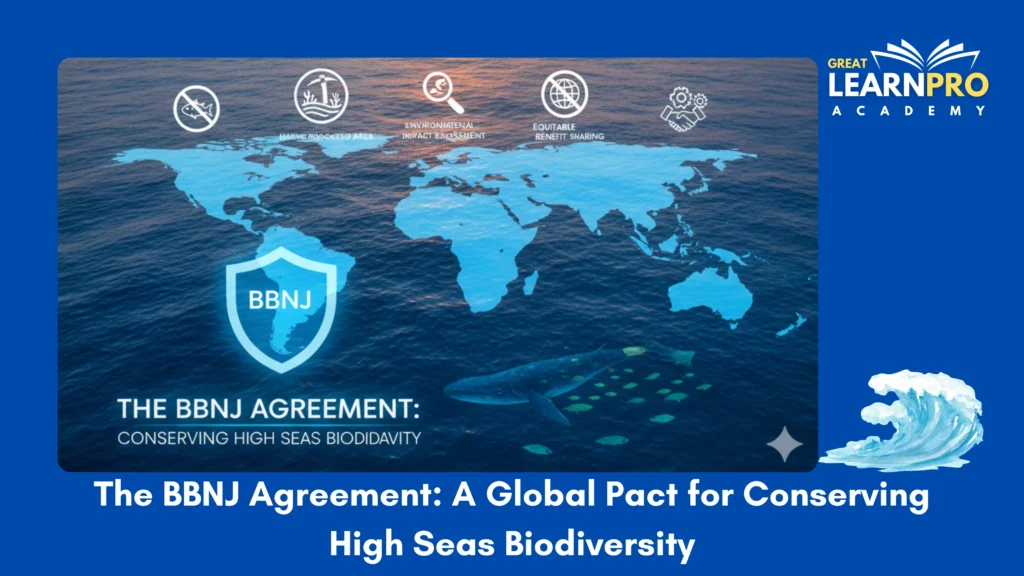
The world’s oceans especially those areas beyond any country’s national jurisdiction harbor some of the most diverse ecosystems on Earth. Yet until recently, there was no comprehensive international treaty specifically designed for their protection. The Biodiversity Beyond National Jurisdiction (BBNJ) Agreement, often called the High Seas Treaty, seeks to fill that gap.
What is the BBNJ Agreement?
Adopted in 2023, under the auspices of the United Nations Convention on the Law of the Sea (UNCLOS), the BBNJ Agreement provides a legal framework to safeguard marine biodiversity in waters beyond national limits. It aims to address several pressing issues:
- Establish Marine Protected Areas (MPAs) in the high seas similar to national parks or wildlife sanctuaries, to regulate human activities and preserve ecosystems.
- Regulate extractive activities such as seabed mining, ensuring that minerals or biological organisms drawn from international waters do not lead to irrevocable damage.
- Mandate environmental impact assessments (EIAs) for major projects that could harm high seas biodiversity—even when the activity is initiated from within a country’s own waters—but with effects beyond their jurisdiction.
- Ensure equitable sharing of benefits arising from marine resources, especially genetic resources and the marine organisms used in research and biotechnology.
- Support developing nations through enhanced access to marine technologies, capacity building, and finance, that they might otherwise lack.
“High seas” and why they matter
The term “high seas” refers to areas that lie beyond any country’s Exclusive Economic Zone (EEZ)—usually beyond 200 nautical miles from the coast. These zones are not under any national control. Approximately 64% of the world’s oceans, or about 50% of Earth’s surface, fall into this category.
These high seas play several crucial roles:
- They are home to many unique marine species and genetic resources that have scientific and possible commercial value (e.g., in medicines).
- They are critical in regulating global climate absorbing carbon dioxide, redistributing heat, and influencing weather patterns.
- They provide resources like fish, minerals, and raw materials beyond national jurisdictions, and in many cases, these resources are exploited with minimal regulation or oversight.
Yet, only about 1% of the high seas are protected under any kind of marine protection regime.
The Status of Signatory, Ratification, and India’s Position
By August 2025, over 140 countries had signed the BBNJ Agreement, with 55 having ratified it, making it binding in those countries.
India signed the treaty in 2024 but has not yet ratified it. Signing indicates intent to comply, but ratification is what legally binds a country to the treaty’s obligations.
In light of this, India’s Ministry of Earth Sciences has set up a 12-member panel to plan how to implement the new law so that India’s interests are safeguarded in international ocean waters.
Significance, Benefits, and Challenges
The BBNJ treaty holds huge promise:
- Environmental protection — By regulating harmful activities and ensuring MPAs, the treaty can help reduce biodiversity loss, preserve marine ecosystems, and protect endangered marine species.
- Climate resilience — Healthy oceans help with carbon sequestration, regulate heat, and stabilize climate patterns. Protecting them is vital in the face of global warming.
- Scientific and economic potential — Genetic resources of marine organisms could lead to new medicines and technologies. The treaty also opens possibilities for equitable benefit sharing.
- Support for developing countries — Since many developing or least developed nations lack the technology or financial resources for marine research or conservation, the treaty aims to provide support to bridge that capacity gap.
But there are also challenges:
- Implementation mechanisms: How effectively can MPAs be enforced in areas beyond national jurisdiction? Monitoring compliance in remote, deep seas is expensive and technically difficult.
- Equity issues: Sharing benefits equitably among countries, especially accounting for past exploitation, difference in capacities, and geographical remoteness, is complex.
- Ratification delays: Countries like India have signed but not yet ratified; without more widespread ratification, the treaty’s global effect will be limited.
- Balancing conservation and exploitation: There will likely be tensions over extractive activities (like seabed mining). Negotiations will be required to strike a balance between economic interests and environmental protection.
Conclusion
The BBNJ Agreement marks a significant milestone in international maritime law and environmental governance. As global civilization grapples with biodiversity loss, climate change, and unsustainable exploitation of natural resources, the treaty offers a pathway to preserving the high seas areas that contribute enormously to planetary health but have long been in the “governance gap.”
For India, ratifying and implementing BBNJ will mean aligning with global norms, protecting marine biodiversity, and reinforcing its leadership in ocean governance. However, doing so will require careful calibration of environmental, economic, scientific, and diplomatic priorities.
In short, if properly implemented, the BBNJ could become one of the defining multilateral agreements of our era a legal and moral landmark for defending the forgotten expanses of the high seas.
Sources:
- https://indianexpress.com/article/india/india-to-enact-law-to-protect-its-interest-in-high-seas-following-bbnj-agreement-10229016/?utm
- https://indianexpress.com/article/india/india-to-enact-law-to-protect-its-interest-in-high-seas-following-bbnj-agreement-10229016/?utm
- https://www.hindustantimes.com/environment/india-is-in-the-process-of-ratifying-high-seas-treaty-jitendra-singh-at-unoc-101749558769463.html?utm_
- https://apnews.com/article/high-seas-treaty-oceans-un-ocean-conference-53ad46ae3cf8737ec82d925761a3d089
More Current affairs: https://learnproacademy.in/updates/
